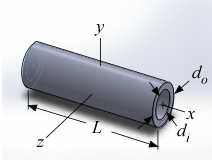
Hollow Cylinder

This procedure returns mass and moments of inertia of a cylinder.
Inputs
d_i =inner diameter of cylinder [m, ft]
d_o=outer diameter of cylinder [m, ft]
L = length of cylinder [m, ft]
rho = material density [kg/m^3, lbm/ft^3]
Outputs
m=mass [kg, lb_m]
I_x = moment of inertia about the x-axis [kg-m^2 or lbm-ft^2]
I_y= moment of inertia about the y-axis [kg-m^2 or lbm-ft^2]
I_z = moment of inertia about the z-axis [kg-m^2 or lbm-ft^2]
Example:
$Load Mechanical
$UnitSystem SI K Pa
$VarInfo I_x units=kg-m^2
$VarInfo I_y units=kg-m^2
$VarInfo I_z units=kg-m^2
d_i=0.1
d_o=0.12
L=0.4
rho=999 [kg/m^3]
Call moi_hollowcylinder(d_i, d_o, L, rho:m, I_x, I_y, I_z)
{Solution:
I_x=0.004212 [kg-m^2]
I_y=0.02052 [kg-m^2]
I_z=0.02052 [kg-m^2]
m = 1.381 [kg]
}
Reference: Juvinall and Marshek, 5th edition, Fundamentals of Machine Component Design, Appendix B-2